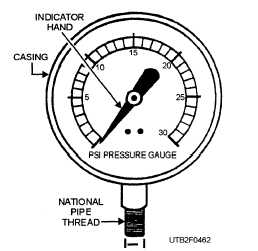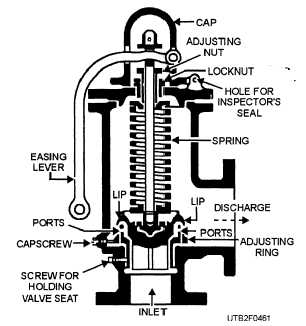pressure-relief valve is shown in figure 4-61. This valve is usually on the top of the boiler. It contains a spring-loaded valve that unseats when the pressure in the system increases to a predetermined value, thereby allowing water to escape until the pressure drops to a safe point. A valve of this type can be adjusted for different pressure.
Pressure-relief valves may eventually corrode and stick if they are not forced to operate occasionally. It is a good practice, once each month, to increase the pressure to a point that operates the valve. When the relief pressure on the gauge exceeds the setting of the valve, check the valve pressure with an accurate gauge and adjust it to the required amount. However, do not exceed the maximum safe pressure of the boiler.
Pressure Gauge
The operator must know the water pressure in the boiler at all times. A gauge is connected to the top of the boiler. It shows the water pressure in the boiler and in the system in pounds per square inch. This gauge is usually a combination gauge that also indicates boiler water temperature and altitude. The type shown in figure 4-62, however, indicates pressure only.
Little maintenance is required for this unit other than to clean the glass so the gauge can be read. Some types of pressure gauges are constructed so they can be re-calibrated. However, the proper equipment to do this is not always available in the heating shop. To calibrate a pressure gauge properly, you must have either a master gauge set or a deadweight tester.

Figure 4-62. - A typical water pressure gauge.
Water-Level Control Valve
Water is added to a hot-water heating system by either a manually operated water valve or an automatic valve, which is controlled by a float mechanism. Both valves are nearly identical to those used in the free-water system of a steam boiler.
Airflow Switch
The airflow switch, or "sail switch" as it is sometimes called, is in the stack, breeching, or the air inlet to the boiler. This switch shuts down the firing equipment in the event of an induced or forced draft failure. To check the operation of this switch, you restrict or shut off the draft. When you have done this, the switch should shut off the burning equipment.
Q25. It is a good practice to test the pressure relief valve by what method and what frequency?

Figure 4-61. - A typical pressure-relief valve.
Q26. What is the name sometime used to refer to an airflow switch?
HOT-WATER HEATING DISTRIBUTION SYSTEMS
Learning Objective: Identify types of hot-water distribution systems and components. Understand the operation and maintenance of these systems.
In hot-water heating systems, the water is heated at a central source and circulated through pipes to radiators, convectors, or unit heaters. There are two general types of low-temperature, hot-water heating systems. The first type is a gravity system in which water circulation depends upon the weight difference between the hot column of water leading to the
Continue Reading